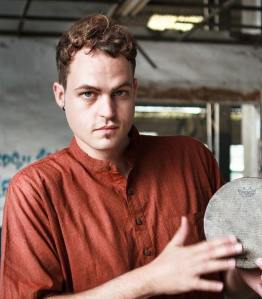FOR SOUTH INDIAN KANJIRA SOLO WITH LIVE ELECTRONICS
多寶格方匣 Duo Bao Ge Fang Xia (“Curio Box”) (2012) is an improvisational environment for the South Indian kanjira drum and a computer assistant running live electronics. Its form incorporates many traditional Carnatic drumming concepts and is based on formal structures that commonly appear in drum solos of classical South Indian [i.e. Carnatic] music. The piece conforms to the Carnatic tala system of rhythm and is governed by the Chaturasra Triputa tala, otherwise known as Adi-tala, consisting of subdivisions that total eight large beats. It is the most common tala found in Carnatic music.
The piece opens with a slower section less dependent on recurring meter, improvisatory, and somewhat analogous to a recitative. This prelude, of sorts, could be heard as a textural dialogue between the live kanjira and the electronic elements, allowing the kanjira player to explore a kind of free timbral expression not usually found in traditional Carnatic drum solos. This section leads to a faster, tempo-based section with lots of subsections and inventive phrase structures. Within this framework the drummer uses a number of common Carnatic transitional devices, such as moras and korvais. These provide forward momentum as well as a rhythmic punctuation between the phrases and subsections. Throughout this recording, percussionist Cody Byassee incurs specific sarvalaghu, or “time flow” patterns that refer to the tala and further lend momentum to the music. Western ears might recognize some of these as “backbeat grooves,” at times even bordering on breakbeats that wouldn’t seem out of place in electronic dance music.
The electronics are entirely based on the analyzed sound of the kanjira and its reconstruction using frequency-based synthesis techniques. The live drum is amplitude-tracked for control over a series of quantized delays. The specific timbres that result are all reworkings of the kanjira’s natural resonances.


